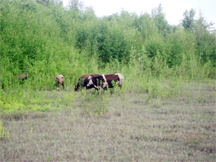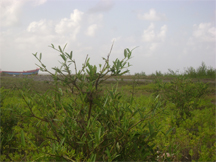A mangrove regeneration project undertaken by the Ministry of Public Works and Communications along the East Coast of Demerara foreshore in the vicinity of Mon Repos has been declared successful but residents in the area have disputed this.

According to a January 19 release from the Government Information Agency (GINA) the project, which is part of the administration’s efforts to strengthen Guyana’s capability to prevent or mitigate floods, commenced in January 2009 where the salt water-tolerant shrub was planted along the villages of Ann’s Grove and Mon Repos on the foreshore.
The mangrove announcement comes amid a flurry of activity associated with the government’s Low Carbon Development Strategy (LCDS) and a recent announcement by President Bharrat Jagdeo that $1b would be expended on the regeneration of mangroves all along the coast. He cited savings to the economy and observers also note that it would be beneficial to the LCDS by creating new growths of carbon absorbing plants.
The GINA release said that the project was successful at Mon Repos where more than 140 meters of the plant was cultivated. It was less successful at Ann’s Grove because of unfavourable conditions to foster growth and according to the release areas with high foreshores will have a greater advantage of growing mangroves.

Stabroek News visited the Mon Repos area last week to have a first-hand view of the project and residents living close by recalled officers from the Sea and River Defence Unit planting the shrub in the area last year but a few months after that, the plants were washed away. In addition they noted that stray animals, mainly cows which roam the boat-building foreshore where the project was carried out, destroyed most of what remained of the mangrove plants. The plants were planted close to another salt water-tolerant plant, the Courida which was clearly visible in the area.
A few cows were seen in the area when Stabroek News visited Mon Repos and according to a fisherman who is also a boat builder, the project was “a waste of time”, since according to him after the planting exercise, the pilot project was not being monitored, especially to ward off stray animals from the area. He said that goats and sheep had been gnawing at the plants leaving only the stem.
When asked about the project being monitored, Agnes Dalrymple, acting Chief Sea and River Defence Officer told this newspaper last week that the department had been closely monitoring the project. When told of what Stabroek News had observed she identified the area where the plants were cultivated, being east and west of a pump belonging to the Guyana Sugar Corporation. Stabroek News revisited the area on Friday and it was the same area where the plants had been destroyed.
According to GINA, Dalrymple stated that man-made sea defence structures that are being constructed cost approximately US$2500-US$4500 per metre. She stated that if the regeneration of mangroves can be encouraged, it will cost the Government less money to protect the coast.
The project is expected to be implemented at other areas along the coast with the West Coast Berbice area identified for regeneration of the plant.
During the commissioning of the Kitty pump station on October 28, 2009 President Jagdeo had said “We are working towards spending, sometime next year, close to a billion dollars on developing a programme” for mangrove replanting. He had added that first of all an assessment of the coastline had to be done “to find out which areas are best suited and what soil types are best suited to the different varieties of mangroves, to bring in a series of specialists who have already successfully deployed planted mangrove, to develop a large scale nursery for the plants, the mangrove plants and to deploy them right across our coastline”.
Jagdeo said that such a move was vital especially given recent estimates produced by the McKinsey Company which says that to properly address the issue of climate change on the country’s coast, will cost in excess of US$1 billion. He said that this was a real challenge, especially if the resources that the country was hoping to receive through the sale of forest carbon do not materialize to the magnitude as expected. The President said that the country would have to fund adaptation measures from the budget.
“There is no other alternative, we can’t give up our coast, we can’t give up the fertile lands here and the housing stock which are so valuable. So we’d have to choose to defend them, this housing stock and…. our people’s livelihood against the sea and against variable, unpredictable, extreme weather conditions”, the President added.
The possibility of cultivating mangroves along the coastline subsequently attracted differing views. In a letter to Stabroek News on November 17,
engineer, Charles Sohan said “President Jagdeo at a recent press conference stated that funds will be made available for mangrove cultivation to protect Guyana’s foreshore and to arrest soil erosion there. In the late 1940s, the Public Works Department with responsibility for sea and river defences, did extensive trials planting mangroves to protect and arrest erosion along selected locations of the foreshore on the Island of Leguan and probably elsewhere.
“Experiments were also carried out on a black sage/bamboo combination strapped together to form a matting, which was then placed over the sloping clay embankment of the river defence system to protect it from erosion. Both these experiments failed to produce the desired effects, and reports on the causes for these failures should be in the records of the Ministry of Public Works and Communications.
“My recollection is that fishermen, vandals and foraging animals played havoc with the young planted mangroves destroying most of them in a short period of time for varied reasons, as the plants struggled to grow and stabilize foreshore erosion in the brackish water of the Essequibo River. With respect to the matting system, the vegetal composition of this could not withstand the pounding of waves generated by the NE trade winds at high tide levels. Hence, the system quickly disintegrated exposing the clay slopes to wave attack and erosion, although subsequently protective action was taken by the construction of concrete/boulder grouted revetments as could be seen at Canefield, Belfield and elsewhere in Leguan.
“It is unwise therefore to spend money resuscitating seemingly failed experimental coastal erosion projects. Rather, sea and river defence works of a more permanent and stable nature which have stood the test of time should be the objective to protect Guyana’s coastline from the constant threat of erosion.” Sohan’s account sounded similar to what Mon Repos residents related to Stabroek News last week.
Sohan’s view was however disputed by a letter the day after from Omadatt Chandan Corporate Secretary of the National Drainage and Irrigation Authority (NDIA) who said “I beg to differ with Mr. Sohan with regard to the proposed mangrove cultivation project by President Jagdeo which would be feasible since it would aid with the issue of soil erosion and help to strengthen the sea defences.”
This was followed up by another letter from Sohan on November 22 which said in part “Mr Chandan claimed that mangrove cultivation as proposed by President Jagdeo would be feasible, implying that mangroves could be successfully planted to aid in preventing soil erosion and strengthening the sea defences. It will be useful if he could indicate the locations in coastal Guyana where mangroves have been successfully planted to achieve these objectives as past experiments have indicated otherwise.” There was no follow-up to this from the NDIA.
